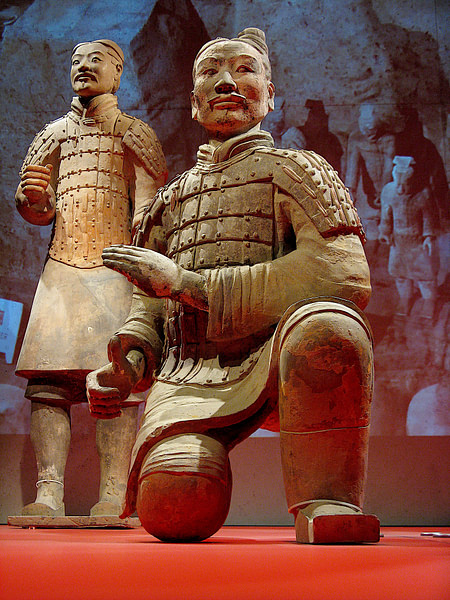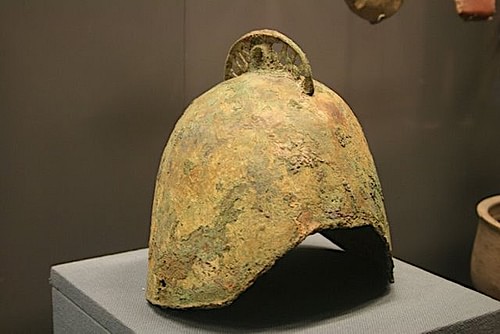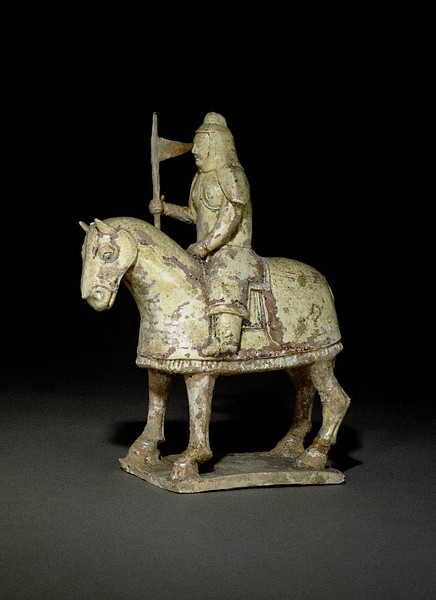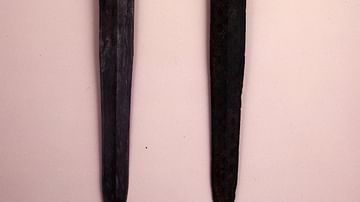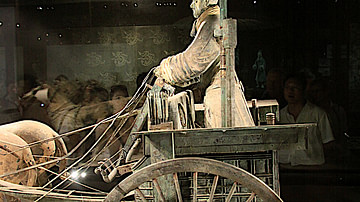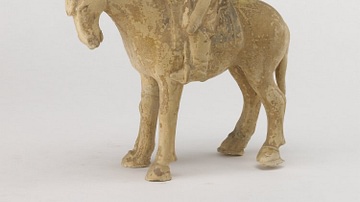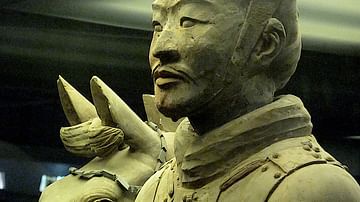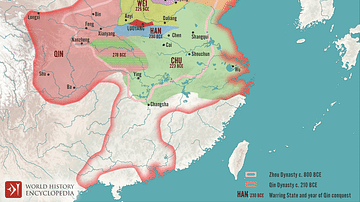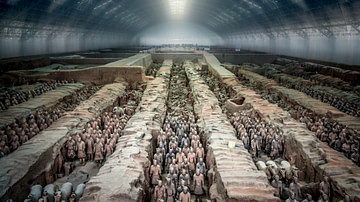With zinging arrows, powerful crossbow bolts, stabbing swords, and swinging axes all a staple feature of the Chinese battlefield, it is not surprising that soldiers sought to protect themselves as best they could with armour and shields. Leather tunics with metal additions, bronze or iron helmets, and shields of lacquered leather helped to deflect at least some of the missiles and slashing blades that came a soldier's way. Horses were similarly protected, and heavy cavalry with the horse and rider covered entirely in armour became a feature of later Chinese armies.
Early Armour
The history and evolution of armour in Chinese warfare is difficult to ascertain with certainty, given its often perishable nature, but text descriptions and appearances in art, such as in wall paintings and on pottery figurines, along with surviving metal parts can help reconstruct major developments. Just who wore armour and when is another point of discussion. Military treatises of the Warring States period (c. 481-221 BCE) suggest that all officers of any level wore armour. The same sources contain references to commanders keeping armour in storage bags and distributing it to troops, but at least some of the ordinary conscripted infantry probably had to provide their own. This obviously depended on their means, and being farmers it is unlikely to have been a realistic possibility for most.
The first armour in China was made from animal skins during the Neolithic period. These were probably not much adjusted for their new function and were likely more intended to impress than deflect weapons. From the Shang dynasty (c. 1600-1046 BCE) leather was used to make tailored armour, and it would continue to be a popular choice for centuries. The most common source of leather was cowhide but the skin of buffalo and rhinos is also recorded (the Sumatran rhino was common in China prior to the 5th century BCE). The tanned and stiffened leather, sufficient to deflect bronze age weapons, was fashioned into two pieces to protect the chest and back of the warrior.
Sometimes pieces of shell were used as an extra layer of protection, and there are remains of armour with high neck protectors. The armour was frequently painted, typically using red, yellow, white, black, and blue. Some were embellished with metal bosses and depictions of fearsome mythical creatures, tigers, or demon masks.
Shields
Shields were in use during the Shang period or even before. Early ones were larger, probably because the body armour of the time was less efficient than later versions. Some combined bronze plates and leather while more rudimentary versions would have been made from whicker, interlaced bamboo or reeds, wooden slats, or animal skins. The leather or layered cloth material was stretched over a wooden or bamboo frame and then lacquered to give extra strength without significantly adding weight. They came in two sizes, a smaller version for infantry and a larger one that could cover the height of a man for chariot riders. The infantry shield was held in one hand, and their remains in tombs suggest they had an approximate rectangle shape, curved slightly outward in the centre, had a single vertical handle centrally placed, and measured 70 x 80 cm.
Helmets
A soldier's head was protected by a helmet made first of rattan or leather and then, later, of bronze. They were typically of a spherical type covering the top of the ears, protected the back of the neck, and were topped by a simple and low crest. Some metal helmets have stylised projections and engravings similar to those used on shields. Bronze helmets were lined with a softer material to cushion blows and for comfort; they weigh on average 2-3 kilos. Helmets were only capable of deflecting light missiles and glancing blows from a sword, and enough skeletal remains evidencing wounds from arrowheads and swords suggests that armour, in general, was not particularly effective in earlier periods of Chinese warfare.
Zhou & Qin Armour
By the middle of the Zhou dynasty (1046-256 BCE) a more flexible armour was devised, made of small overlapping rectangles of leather held together using leather thongs, hemp cord or rivets, and made into the form of a tunic. Each piece of leather was hardened by tanning and lacquering. This type of armour is typical of the warriors of the Terracotta Army found in the tomb of Shi Huangdi, the first emperor of the Qin dynasty (221-206 BCE). The terracotta warriors display seven different types of armoured tunic, some with extended flaps to protect the groin. An alternative to leather was to use small rectangles of bronze or a layered combination of bronze and leather. Naturally, too, many soldiers who could afford it adorned their armour with extra decorations designed to impress and made from precious metals, ivory, and rhinoceros horn.
Han Armour
With the wider use of the crossbow and their increasing firepower, especially from the Han dynasty (206 BCE-220 CE) onwards, iron was increasingly used in body armour. Again, small plates were stitched or riveted together to form a semi-flexible tunic which also protected the outer upper arms. Iron was at the same time used to strengthen shields and to make helmets. Helmets of this period take on a hood-like shape with a hanging part to protect the neck but they still offered no protection for the face, even if there are references to iron face-masks in Han military treatises.
Another development was to design armour for specific types of soldiers. The two or three soldiers within a chariot did not need any great mobility, and so their armour could be heavier and more cumbersome but with the benefit of offering greater protection. All of the body could be covered, provided the arms were left free to wield weapons such as lances and halberds (a mix of axe and spear). Infantry, meanwhile, had only short tunics and more basic leg protectors which allowed them to move quickly across the battlefield. Cavalry, which began to replace chariots from the 4th century BCE, were traditionally lightly armed with halberds and bow so that in order to move freely and fire from their primitive saddles while still on the move their clothing had to be light and unrestrictive.
Horse Armour
The horse had, if any, only the limited protection of a hanging leather cover over its front below the neck and sometimes a tiger skin spread over its flanks. With the invention of the stirrup, a heavy cavalry became possible from the 4th century CE. These cataphracts had all-over body armour for both rider and horse and can be clearly seen in pottery figurines of the period. The great weight of such heavy cavalry impeded their use in practical terms and, consequently, there was a return to lighter and faster cavalry in the Tang period (618-907 CE), even if a small corps of gentlemanly knights continued well into the medieval period.
Later Armour
During the Sui dynasty (581-618 CE) and the succeeding Tang dynasty periods, a new armour developed which became known as “cord and plaque”. Seen in pottery figurines of the time, the armour was composed of large iron plates joined by cords running down the centre and across the chest and linked to a cord belt, which probably helped distribute the weight away from the shoulders. Another popular type during the Tang was a long coat of armour made from hundreds of small metal plates and which hung down almost to the ankles.
In medieval China, armour became even more ornate with intricately designed suits of armour made of fabric-covered riveted panels, armour which covered the tops of the legs for cavalry, and helmets made from multiple overlapping plates of iron or even sometimes engraved silver. Mail armour was used but rarely and, despite the arrival of gunpowder and firearms, Chinese armour remained remarkably traditional with leather still being commonly used for all types of warriors just as it had been for over two millennia.
